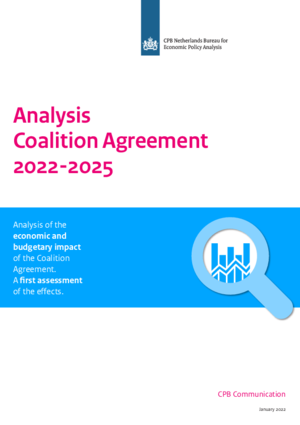Analysis of the economic and budgetary impact of the Coalition Agreement

The effects were set against the baseline situation on the Day of the King’s Speech (Prinsjesdag) 2021, supplemented by the decisions taken since then. The purchasing power picture has been corrected for inflation. The bassline was not adjusted for changes in economic insights and circumstances since publication of the medium-term outlook, with one exception: for the purchasing power pattern for 2022 and 2023, we used the inflation estimate of the Dutch central bank (De Nederlandsche Bank (DNB)). Changes in the underlying economic picture will generally not have a major impact on the effects from the policy package. In March of this year, as in past years, CPB will present its new projections in which the latest insights will be incorporated.
Downloads
This is explicitly a first estimate of the effects; many proposed policies have not yet been worked out in detail. Where necessary and possible, assumptions have been made in order to make the calculations. If, during the current government’s term in office, a design would be chosen that differs from that in our assumptions, the budgetary and economic effects may deviate from the figures presented here.
A number of spending cuts have not been sufficiently worked out to achieve the intended savings. Some measures aimed at limiting increasing costs in health care were not or not fully included in our analysis, because they have not been sufficiently elaborated. This does not mean that these spending cuts are impossible, but it does mean that CPB expects further measures are needed if the intended saving is to be realised.
The package of policy measures contains a substantial amount in spending increases; here, CPB assumed that not all these financial resources will be spent within the current government's term in office. Given the shortages on the labour market, we consider it unlikely that all the planned additional financial resources for infrastructure and defence will be spent within this government's term in office and, therefore, our analysis takes underutilisation into account. On balance, a spending boost of 26.1 billion euros will remain in 2025.
Contacts


